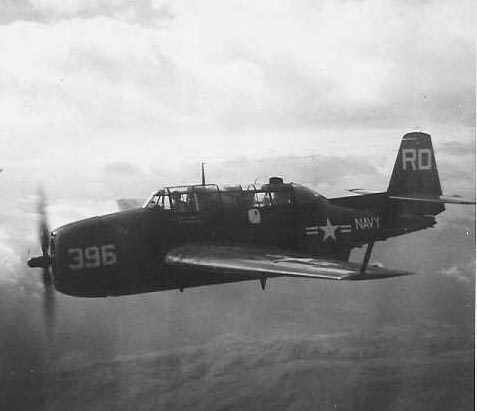|
|
Squadron Scrapbook
|
|
|
Squadron Scrapbook
|
The following account summarizes available information on accidents involving TBM aircraft belonging to VR-24 Det Naples and FASRON-77.
 |
| Photo of TBM 396 enroute to Athens by Guidotte from TBM 404 |
On 16 March 1955, TBM3R BUNO 69396
(VR-24 Det. side number 396) crashed into the sea shortly after takeoff
from Athens. The aircraft was returning to the field because of a tail
heavy condition. Lost in the accident were LCDR Fred M. Walters, the
plane’s pilot, and AD3 Albert H. Lucas, the enlisted plane captain.
The following is Gene Guidotte’s first-hand account of the loss of TBM
396 and its crew of two.
We departed Naples on 14 March 1955 for Athens in a flight of three TBMs
with the following crews; 404, LCDR Walters and Guidotte; 396, LT Ailes
and Lucas; 616, LT Doss and J. Hill. AMH3 Gordon Hall was also on the
trip and he and I still hash over a lot of the events that happened.
Upon landing at Athens International airport, LCDR Walters informed me
that the plane’s emergency fuel pump was inoperative and he would order
a replacement.
We were scheduled to make a run to the USS Randolph on the 16th. When we
got to the airport that morning, my new fuel pump had just arrived.
LCDR Walters told me to stay and replace the pump. He needed the
landing so he was bumping LT Ailes and taking TBM 396 with Lucas as
plane captain out to the Randolph. Gordon Hall, who was along as
maintenance support, helped me change the pump. After installing the new
pump, I started the aircraft for preflight while Hall stood guard with a
fire bottle. TBMs 396 and 616 had already taxied out from parking by
that time. As I ran the engine up, I saw Hall waving his arms for my
attention. When I throttled back, he jumped up on the wing and said,
"They crashed!" I asked, "Who!", to which he responded, "A TBM!"
I immediately called Athens Tower on VHF and told them that one of our
aircraft had crashed. They said that they already knew about it. When I
asked why their emergency vehicles weren't going anyplace they didn't
answer.
I shut down the aircraft and Hall and I went to the U.S. Air Force
Section on the field and asked for a ride to the crash site. We went out
the gate, took a left and followed the shoreline to where we could
finally see one landing gear sticking out of the water about 1500 feet
from the shore. Hall said that the aircraft had flipped over in the air
before he lost sight of it. I got a fisherman in a small boat to take me
out to the aircraft. It was upside down in about 15 feet of water. The
water was covered with fuel and hydraulic fluid. The whole greenhouse of
the aircraft was crushed flat. Lucas had told me before takeoff that he
was going to ride in the top compartment for a scenic trip. The aft crew
compartment was the only part of the aircraft that anyone could have
survived in and he wasn't riding there.
The Air Force decided to drag the aircraft in by winch. I had a few
things to say to the Colonel in charge about trying to get divers down
to remove the crew but I was told to butt out.
Two days later, I flew out to the Randolph with LT Ailes in TBM 404. It
was my worst landing. We went back to Naples on the 19th after going to
Izmir, Turkey, then making a run out and landing on the USS Lake
Champlain.
ADR3 Ron Wardell accompanied Lucas home. The athletic field at NAF
Capodochino was later named for LCDR Walters. He had refereed a lot of
the games played there.
LCDR Walters was also a qualified LSO. When we made a trip to Hyeres
(Toulon), France, home of French Naval Air, we were met by a group of
French aviators whom LCDR Walters had checked out as LSO’s. I got the
VIP treatment. They even washed my aircraft during the night and
replaced some missing Dzus fasteners. LCDR Walters was a great officer
and everybody's friend. We missed them a lot. There were a lot of reasons why
this accident should never have happened.
This was the only fatal accident involving a VR24 TBM. A FASRON-77 TBM
(side number 622) crashed at Capodochino after a wave off. It was lost
prior to the COD operation being transferred to VR24. The transfer took
place around May 1954. The pilot who died was a Chief Aviation Pilot
(AP) Norman. Two Army passengers also died in the crash, but an Aviation
Metalsmith (AM) who was getting his time in, survived. The reason the
TBM was going around was that while the Navy controller was bringing it
in for a landing, an Italian controller gave a civilian aircraft
permission to takeoff on the opposite end of the runway.
Gino
|
(guidotte collection)
(hurt collection) |
Top of Page
Next Page
Go Direct to Accidents Page (1),
(2),
(4),
(5)
(6)
Return to Scrapbook Page One
Return to Home
Page